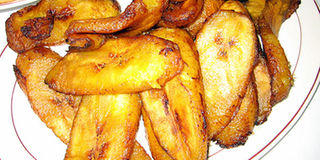Prime
Gonja, the tasty sweet plantain

Gonja, deep fried, is a delicacy at parties. File photo
What you need to know:
GONJA. The sweet plantain, though not associated with a particular tribe in Uganda, is quite popular in Uganda. This delicacy can be found on the roadside in most suburbs, homes, as well as restaurants and hotels.
If one were to serve a Muganda gonja in place of matooke, this would be an egregious mistake. Be that as it may, gonja is a firm and prominent member of the plantain family and moreover, according to FAO figures of 2009, Uganda is the world’s largest producer of plantain harvesting an impressive 9.5 million metric tons followed by Ghana, Columbia, Rwanda and Nigeria.
Gonja can never be eaten raw and must be cooked before eating. They can be green yellow or very dark depending to the degree of ripeness.
In Uganda, the three most common forms of cooking gonja are viz. fried, boiled or steamed and charcoal broiled. However, gonja can be served mashed though this is not often the case in Uganda. When it comes to the spicing up of gonja, Ghana is miles ahead of us. It is an unwritten cardinal rule in Uganda that gonja must be cooked au naturel and there is never any deviation from this norm.
When creativity comes into play
The versatility of gonja is remarkable and with some creativity one can serve the vegetable as an appetizer, in soups and even desserts. In the past, gonja was unlikely to be found in restaurants; most people had to make do with buying it in the market and serving it from home. However, nowadays, places such as Javas Café make it a point to have it on the menu and you will be surprised how many people order gonja by the plate. Similarly, Mama Ashanti who specializes in West African fare serves a wickedly hot and spiced fried plantain in palm oil and Kelewele peppers.
Roadside delicacy
Gonja is commonly served year round with the most common form being the charcoal broiled which is easy for the women who cook by the roadside in the suburbs. This type of cooking requires little start up money; a sigiri with grill and some gonja and one is in business. Pricing is informal and at times you can get great bargains if the vendor has a lot in stock that is ripe. Price range of a raw bunch is Shs2, 500 to Shs5000. The charcoal grilled gonja would set you back by Shs1000 for a pair. Unfortunately, rather like avocado, when you buy a bunch, it tends to ripen at the same time.
If you are preparing gonja at home, I find that the best way is to buy gonja that is ripe and ready to be used within a day or two. Buying a whole bunch can prove to be very costly and you may even end up with a lot of overly ripe gonja that may not have much appeal to the family.
Most local markets do not keep gonja in stock since it is fairly expensive and considered more of luxury than a staple such as matooke, cassava or sweet potatoes. However, Nakasero market always has gonja in abundance (both ripe and green) and though you will pay a high price, you are guaranteed that you will be able to buy it as and when you need it.
One of my favourite and a novel way of preparing gonja is with sweet potatoes in the form of crisps. This is an easy-to-prepare recipe and you are bound to impress the family.




